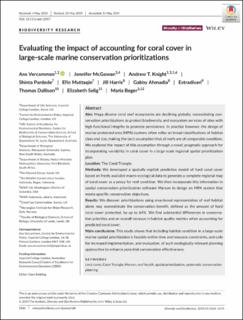| dc.contributor.author | Vercammen, Ans | |
| dc.contributor.author | McGowan, Jennifer | |
| dc.contributor.author | Knight, Andrew T | |
| dc.contributor.author | Pardede, Shinta | |
| dc.contributor.author | Muttaqin, Efin | |
| dc.contributor.author | Harris, Jill | |
| dc.contributor.author | Ahmadia, Gabby N | |
| dc.contributor.author | Estradivari, * | |
| dc.contributor.author | Dallison, Thomas | |
| dc.contributor.author | Selig, Elizabeth | |
| dc.contributor.author | Beger, Maria | |
| dc.date.accessioned | 2020-09-17T09:06:17Z | |
| dc.date.available | 2020-09-17T09:06:17Z | |
| dc.date.created | 2020-01-10T16:39:41Z | |
| dc.date.issued | 2019 | |
| dc.identifier.citation | Diversity and Distributions: A journal of biological invasions and biodiversity. 2019, 25 (10), 1564-1574. | en_US |
| dc.identifier.issn | 1366-9516 | |
| dc.identifier.uri | https://hdl.handle.net/11250/2678197 | |
| dc.description.abstract | Aim Mega‐diverse coral reef ecosystems are declining globally, necessitating conservation prioritizations to protect biodiversity and ecosystem services of sites with high functional integrity to promote persistence. In practice however, the design of marine‐protected area (MPA) systems often relies on broad classifications of habitat class and size, making the tacit assumption that all reefs are of comparable condition. We explored the impact of this assumption through a novel, pragmatic approach for incorporating variability in coral cover in a large‐scale regional spatial prioritization plan. Location The Coral Triangle. Methods We developed a spatially explicit predictive model of hard coral cover based on freely available macro‐ecological data to generate a complete regional map of coral cover as a proxy for reef condition. We then incorporate this information in spatial conservation prioritization software Marxan to design an MPA system that meets specific conservation objectives. Results We discover prioritizations using area‐based representation of reef habitat alone may overestimate the conservation benefit, defined as the amount of hard coral cover protected, by up to 64%. We find substantial differences in conservation priorities and an overall increase in habitat quality metrics when accounting for predicted coral cover. Main conclusions This study shows that including habitat condition in a large‐scale marine spatial prioritization is feasible within time and resource constraints, and calls for increased implementation, and evaluation, of such ecologically relevant planning approaches to enhance potential conservation effectiveness. | en_US |
| dc.language.iso | eng | en_US |
| dc.publisher | Wiley | en_US |
| dc.rights | Navngivelse 4.0 Internasjonal | * |
| dc.rights.uri | http://creativecommons.org/licenses/by/4.0/deed.no | * |
| dc.title | Evaluating the impact of accounting for coral cover in large-scale marine conservation prioritizations | en_US |
| dc.type | Peer reviewed | en_US |
| dc.type | Journal article | en_US |
| dc.description.version | publishedVersion | en_US |
| dc.source.pagenumber | 1564-1574 | en_US |
| dc.source.volume | 25 | en_US |
| dc.source.journal | Diversity and Distributions: A journal of biological invasions and biodiversity | en_US |
| dc.source.issue | 10 | en_US |
| dc.identifier.doi | 10.1111/ddi.12957 | |
| dc.identifier.cristin | 1770542 | |
| cristin.ispublished | true | |
| cristin.fulltext | original | |
| cristin.qualitycode | 1 | |

